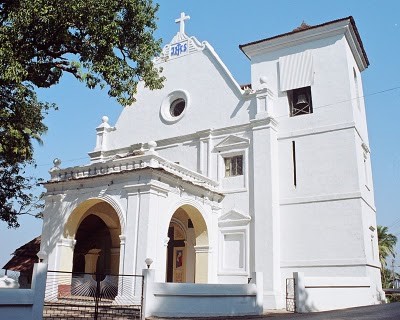An interesting legend surrounds The Our Lady Of Ajuda Church. It’s located in Ribander, which was originally a chapel dedicated to Our Lady of Immaculate Conception, under the ecclesiastical jurisdiction of the Church of Our Lady of Livra Febres in Chimbel.
What could have been the legend that was so great that needed a new church to be built for devotees?
The legend of Our Lady of Ajuda…
It is said that a Portuguese ship was found in desperate straits stumped thanks to a storm. The ship was badly damaged and in peril of sinking along side the crew.
That is when the captain and therefore the crew prayed to Our Lady for cover and help. Then, they saw a vision of Our Lady within the sky and heard a voice urging them to travel to the river banks and walk. Our Lady helped them reach near the chapel and move to safety. The sailors who salvaged the wreck rushed to the chapel to thank and pray to Our Lady of Immaculate Conception and vowed to create a church in her honour.
The size of the ship is indicated by two crosses erected on the margin at a distance of 102 meters from one another . The church is claimed to be of the size of the ship.

The history of Our Lady of Ajuda Church
Different dates are given regarding the erection of the church. Jose Nicolau da Fonseca in ‘Sketch of the town of Goa’ mentions that it had been inbuilt 1565 whereas from the title of book ‘Titulo de todas as despesas ordinarias que se fazem na Cidade de Goa a custa de Fazenda de S.A., ano 1575-1576’ we get to know that the date of construction of the church is affixed at ten year after the aforementioned date.
Gomes Catao writes within the Anuario that the church was inbuilt 1656, while the documented Jesuit scholar Fr G Schurhammer SJ, says that the Ribandar church was built before 1539.
In 1554, when the body of St Francis Xavier arrived from Malacca it had been kept within the church thanks to pending finalisation of arrangements for the reception of the body at the City of Goa.
Our Lady of Ajuda Architecture
The church is an architectural example of early Mannerist Neo-Roman style and has four bays and three storeys. The façade may be a peaked gable and has an oculus within the centre. At the apex, may be a cross below which, on the wall, is inscribed ‘IHS’. It has an outsized three storey tower to the proper. There is a porch ahead of the church, with arches and ball finials. In front of the church, there’s an enormous cross that when belonged to the Chorao Seminary.
The Feast of Ribandar Church
In the past, on the fete day , sailors of the Portuguese Navy in India wearing their uniforms wont to carry the ship within the procession. Later, boys dressed as sailors participated within the procession and carried the miniature ship, which was fitted with all the accessories of an authentic ship.
Today the tradition of dressing up in uniform isn’t followed. However, the ship is carried during the procession. The miniature ship is very old. It has a picture of Our Lady on board and has wheels at rock bottom to facilitate carrying it during procession.

The Church Today…
Since the church is under renovation, it had been impossible to ascertain this condition of the altars and interiors of the ship and therefore the present description is predicated on the documents available, especially from a piece of writing by Ricardo Micael Telles in ‘A Voz de S Francisco Xavier’, ‘Anuario da Arquidiocese de Goa e Damao’ and ‘Tiswadicho Igorjeo’ by Fr Moreno de Sousa.
Above the arch of the most altar may be a painting of a ship with Our Lady depicted thereon. A similar fresco is found on the outside wall, on the side of the river. The false ceiling had panels depicting episodes from the Old Testament.
Legends say that the false ceiling was built from the wood of the wrecked ship. The hewn beams that when supported these panels today dwell the corridor of the church and cemetery. The panels were beautiful encircled as they were by lace woodwork. They were the work of an Italian artist. These panels were lost in 1900 when the repair work of the church was undertaken.
Deep within the main altar, which is devoted to the patron, may be a niche for the chapel of Holy Eucharist lined with gold plating, which is now covered with a throne. The altar belonged to the school of Our Lady of Populo or Saint Augustine and was placed within the church in 1841 along side large images of Saint Augustine, Saint Antony and Saint Peter. To the proper of Our Lady of Ajuda is placed Saint Anthony and Saint Monica. On the left is Peter and Saint Augustine.
Collateral altars are dedicated to Our Lady of Monte and Jesus Crucified. Above the altar, there’s a picture of St Miguel with Our Lady of Prazeres and Saint Joseph on the side, which belonged to the extinct church of Saint Thomas. Below is statue of Saint Francis Xavier.
Above the second altar is that the statue of Jesus Resurrected (Senhor Ressussitado) and below is that the statue of Menino Jesus. Saint Sebastian and Our Lady of Assumption are on the side.
In the sarcophagus is that the image of Jesus (Senhor Morto). The pulpit features a niche with the image of Our Lady of Immaculate Conception, which belonged to the traditional chapel. In the body of the church is that the altar, which consistent with Telles, was from the Inquisition. The altar features a big crucifix, images of Our Lady, Saint John and Saint Maria Maddalena. The altar before being installed within the church was kept within the arsenal.


